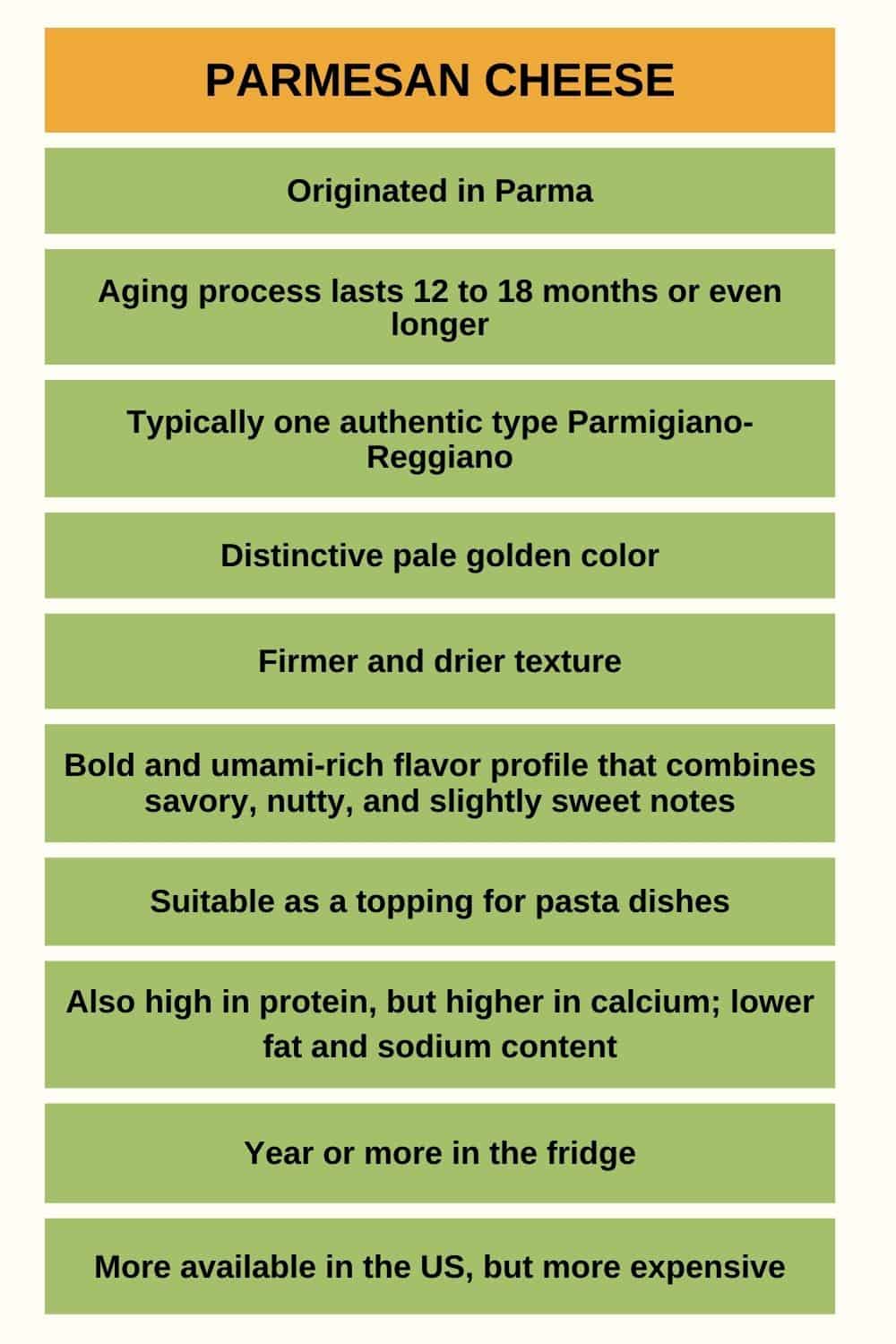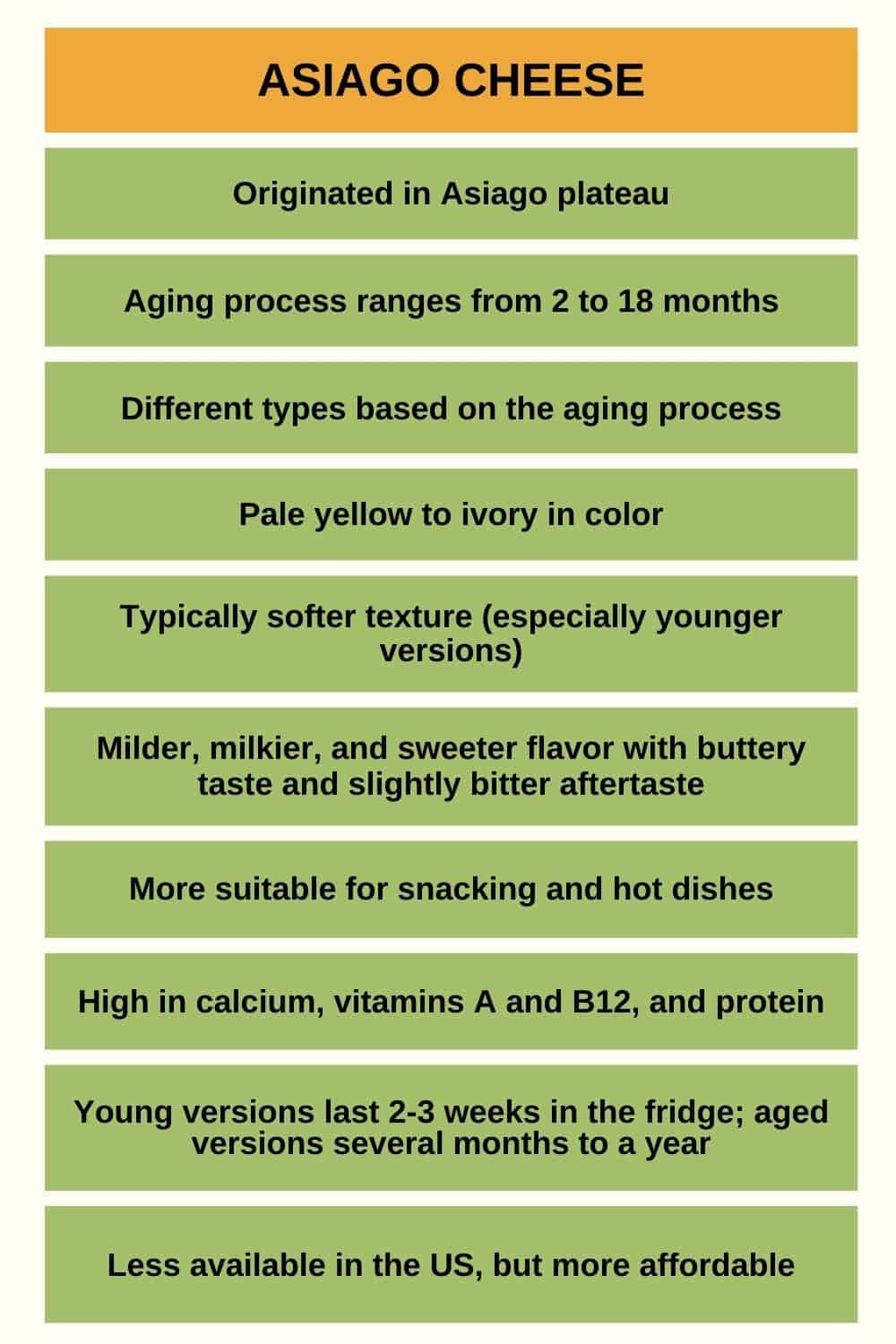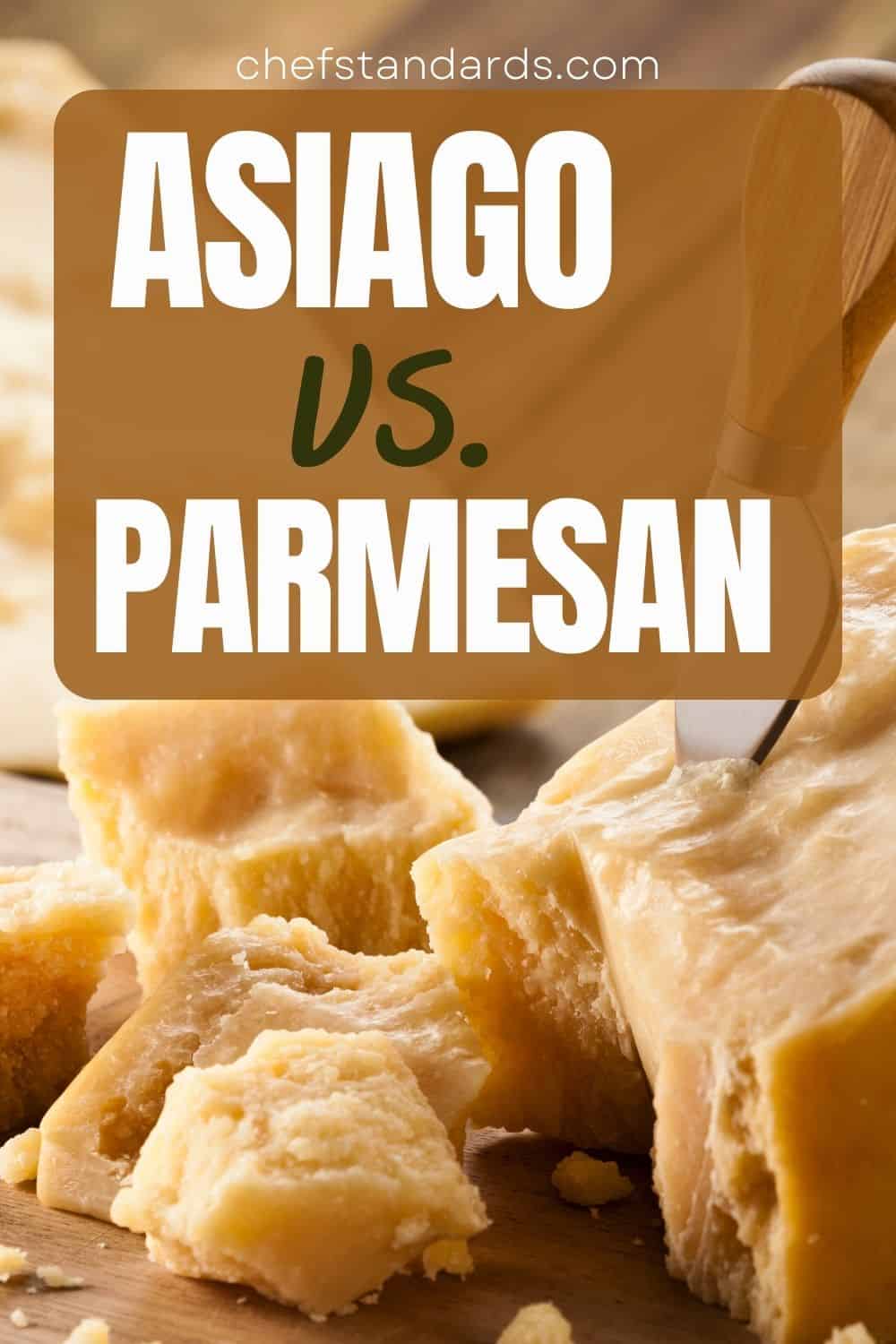I know very few people who don’t like cheese or some cheese product. From classics like pizza and pasta to delicious and juicy hamburgers and cheeseburgers, it can enrich so many culinary delights.
One of the most popular types is definitely a classic cheese from Italy, known as Parmesan cheese or Parmigiano-Reggiano. It is widely recognized and celebrated for its distinctive flavor and texture.
But do you know about another one from Italy, known as asiago cheese? I assume that you did, but do you know what it actually is and how it is different from Parmesan cheese?
Those two types of cheeses are quite similar in color, flavor, texture, and uses, but they are not the same and have some distinctive differences that I will discuss here.


Decoding Asiago
I will start with Asiago cheese, one of the oldest varieties of Italian cheese. Hailing from the picturesque Asiago plateau in northern Italy, it is a semi-hard Italian cheese that has gained popularity for its unique flavor and versatility in culinary applications.
The production of Asiago cheese can be linked to the agricultural practices and culinary traditions of the region.
Although Asiago cheese is mostly made from cow’s milk nowadays, it was initially made from sheep’s milk, and that was between the 10th and 15th century.
Only in the 16th century, cow’s milk took the dominant role in producing this cheese variety. When it comes to that same production process, it begins with heating the milk, coagulation using rennet, and separating the curds from the whey.
The curds are then pressed into molds, creating the characteristic shape of Asiago cheese. After the initial production process, Asiago enters the aging process, which is normally for 2-18 months.
The aging process is very important because it is the factor that determines flavor, texture, and color of the cheese, as well as the exact type. Based on that, there are a few types of Asiago cheese:
• Asiago Pressato or Pressed Asiago: Aged for only 20-40 days; Very pale yellow in color; Medium-soft texture and soft, edible rind; Mildest flavor.
• Asiago d’Allevo: Aged for about 60 days or longer;; Made with a mixture of whole milk and skimmed milk; Harder texture with fewer “eyes”; Darker color; Harder rind that must be discarded; A bit stronger flavor.
• Asiago Mezzano or Middle Asiago: Subtype of Asiago d’Allevo; Aging process 4-8 months; Bright straw-yellow color; Dense texture; Similar flavor intensity.
• Asiago Vecchio or Old Asiago: Another subtype of Asiago d’Allevo; Aged between 9-18 months; Hard and crumbly texture; bright straw-yellow or darker yellow color; Strong flavor.
• Asiago Stravecchio or Very Old Asiago: Final subtype of Asiago d’Allevo; Aged for more than 15 months; Very dark yellow color; Very hard, dry, and grainy texture; Strongest flavor.
Decoding Parmesan
Then there is Parmesan cheese, also known as Parmigiano-Reggiano in its authentic form. It is an Italian cheese classic that spread its dominance around all world cuisines with its distinctive flavor, granular texture, and centuries-old tradition.
Parmesan cheese traces its roots back to the regions of Parma, Reggio Emilia, Modena, Bologna, and Mantua in northern Italy.
It is made from cow’s milk obtained from local dairy farms, following a traditional production process that has been preserved for generations.
The production of Parmesan cheese begins with the careful selection of high-quality milk from cows fed on a special diet, including local forage.
The milk is heated and mixed with rennet, a natural enzyme, to initiate coagulation. This forms curds that are then broken into small granules and cooked in large copper vats.
After cooking, the curds are pressed into molds, which impart the characteristic shape and size of Parmesan cheese wheels. The cheese wheels are immersed in brine to enhance their flavor and promote rind formation.
Like with Asiago cheese, the aging process follows the production process, but it is even more crucial for the development of Parmesan cheese’s unique flavor and texture.
Compared to Asiago cheese, the aging process typically lasts much longer. Younger Parmesan ages around 12 to 18 months and has a balanced flavor profile.
As it ages more, Parmesan develops a deeper and more complex flavor profile. I have to emphasize that long-aged Parmesan cheese is well-respected and, therefore, it is also more expensive.
Asiago Vs Parmesan: 7 Key Differences
I have provided some main information about both types of cheese, but the main difference between these two is what we are all really interested in. So let’s dive in and find out.
1. Color

When it comes to the color of these two types of cheese, the most important thing to know is that the color of Asiago mostly depends on the aging process.
Younger varieties of Asiago cheese have a pale yellow or ivory color. As Asiago cheese ages, it undergoes changes in color.
Aged Asiago develops a darker hue. The aging process can contribute to a darker golden-yellow to amber color, sometimes even with subtle hints of brown.
The longer the aging period, the deeper the color of the cheese, that’s for sure.
On the other hand, authentic Parmesan cheese has a uniform color throughout the wheel, and the aging process does not have that much influence.
Parmesan cheese is renowned for its distinctive pale golden color. It has a characteristic ivory to a light yellow hue, which is a result of the specific production methods and the aging process.
However, I have to emphasize that this strictly counts for authentic Parmesan cheese.
Some commercially produced parmesan cheeses can have a different color or some discolorations due to slightly different production methods, various additives, or different types of milk.
2. Texture
Much like the color, the exact texture of Asiago cheese also depends on the aging process. In general, Asiago cheese has the status of hard cheese because it is traditionally aged to full ripening.
When this is the case, it typically has a firm and dry texture. If it undergoes a really long aging process, Asiago cheese becomes more crumbly and granular.
As it ages, it also develops small, crystalline structures that contribute to a delightful, slightly crunchy texture. Also, you won’t be able to see many, if any at all, holes on well-aged Asiago cheese.
The different story is with younger Asiago cheese varieties. They typically have a semi-soft and elastic texture. It is supple and smooth, making it easy to slice or spread.
It can not be said that it does not contain any firmness, but it is still quite pliable, allowing for a pleasant mouthfeel. Also, similar to some types of popular Swiss cheese, it has many “eyes”, especially when compared to aged Asiago.
Parmesan cheese, on the other hand, has a distinct texture that is granular and crumbly. It is a hard cheese with a firm, dense structure. This is the result of its extended aging period.
During this time, the cheese develops small, grain-like crystals that add a unique crunchiness to the texture. Asiago cheese that was aged for a very long time has a similar texture to authentic Parmesan cheese, but it is still not as firm as Parmesan.
When freshly grated, Parmesan cheese has a powdery consistency due to its dry texture. It can be easily sprinkled or grated over dishes, adding a delightful texture and enhancing the overall culinary experience.
3. Flavor
Once again, the aging process plays a crucial role. Generally speaking, Asiago cheese is milder, milkier, and sweeter than Parmesan cheese. It also has a more pronounced buttery taste with a bit of bitter aftertaste.
This is especially the case with young Asiago cheese as it offers a delicate and subtle taste, with just a slight tanginess. The flavor is also quite creamy and milky, without being overpowering.
As it ages, it develops a more pronounced and complex flavor. The aging process contributes to a richer and nuttier taste, with hints of caramelization and slight sweetness.
Aged Asiago can have a slightly sharper and tangier flavor compared to the younger version. The longer the aging period, the more intense and concentrated the flavors become, resulting in a robust and distinct taste.
Also, as it ages, it becomes more similar to Parmesan cheese, and it can be fairly said that long-aged Asiago cheese tastes quite similar to moderate-aged Parmesan cheese.
When it comes to Parmesan cheese, in its authentic form, it takes on a bold and umami-rich flavor.
It has a complex taste profile that combines savory, nutty, and slightly sweet notes, somewhat similar to, which is why it can be a great Pecorino cheese substitute. The bitterness is more pronounced compared to Asiago.
Parmesan cheese can have hints of caramel, butter, and even subtle herbal undertones, adding to its distinctive flavor profile.
4. Uses

When I first tried Asiago, I enjoyed it with crackers on a cheese board and it was a delicious tasting experience. Its mild and buttery flavor makes it pair well with fruits and bread as well, offering a pleasant snacking option.
If you are a fan of Italian cuisine and culture, it can be an excellent part of your morning Spuntini.
Asiago can even serve as a great vegetarian alternative to prosciutto.
Aside from enjoying it as a snack, you can also use it in various hot dishes as it melts well.
Melting the cheese in the microwave is the most practical option.
You can use it as a topping for pizzas, sandwiches, and paninis, adding a creamy and slightly tangy note.
Finally, Asiago cheese can be grated and sprinkled over pasta, risottos, and salads, adding a subtle and creamy flavor. And you can also use it as a finishing touch in soups and gratins.
Parmesan cheese, on the other hand, is not so suitable for snacking and enjoying it on a cheese board. But in many other culinary actions, it can be an amazing ingredient.
Grated Parmesan has a fine powdery consistency, which makes it perfect for using as a topping for pasta dishes. Those include spaghetti, lasagna, and carbonara, as it enhances the flavor and provides a savory kick.
You can also incorporate it into salad dressings, marinades, and creamy dips, in order to provide a tangy and savory element. Parmesan can even be an interesting flavor twist in a turkey sandwich.
Finally, some people use it as a garnish, sprinkling it on top of salads, roasted vegetables, or grilled meats, adding both visual appeal and a burst of flavor.
5. Nutrition
Asiago and Parmesan cheeses are actually quite similar when it comes to nutrition profiles, but there are some differences worth mentioning.
Asiago cheese is a good source of protein, calcium, and phosphorus. It also contains moderate amounts of vitamins, such as vitamin A and vitamin B12.
Parmesan cheese also contains all of these nutrients, but it is even higher in calcium. The great thing about Parmesan is the fact that it is relatively low in lactose, making it suitable for individuals with lactose intolerance.
When it comes to fat content, Asiago cheese typically has a slightly higher fat content compared to Parmesan cheese.
Parmesan cheese is a lower-fat cheese compared to many other types of cheese. It is also relatively low in sodium than some processed cheeses.
Both types of cheese are great sources of proteins, which are essential for building and repairing tissues, supporting immune function, and providing energy.
All in all, both types of cheese are great sources of nutrients, including calcium, vitamins A and B12, as well as proteins.
However, I would give a slight advantage to Parmesan because it has a lower fat and sodium content, as well as a higher amount of calcium.
6. Shelf Life and Storage
Like with color, texture, and flavor, the exact shelf life of Asiago cheese mainly depends on the aging process.
Young Asiago cheese can last for about 2 to 3 weeks when properly stored in the refrigerator.
Aged Asiago cheese, on the other hand, can have a significantly longer shelf life, ranging from several months to a year or more.
To maximize the shelf life of young Asiago cheese, it is important to wrap it tightly in plastic wrap or place it in a resealable plastic bag to maintain its freshness and prevent moisture loss.
Aged Asiago cheese can be wrapped in wax or parchment paper, followed by aluminum foil to protect it from drying out. Finally, it is important to store both of them in the fridge at a temperature between 34-38°F (1-3°C).
Parmesan cheese has a very long shelf life due to its low moisture content and aging process. Authentic Parmigiano-Reggiano, when properly stored, can last for many months or even up to a year.
However, proper storage is essential and it is best to wrap it tightly in wax or parchment paper, followed by aluminum foil or a plastic bag to minimize exposure to air.
It should then be stored in the refrigerator at a temperature between 34-38°F (1-3°C).
7. Price and Availability
The price of Asiago cheese can vary depending on the age and variety. Generally, young Asiago cheese is more affordable compared to aged Asiago cheese.
Asiago cheese is widely available in regions where it is produced, primarily in Italy and parts of Europe. In these areas, you can find it at local markets, cheese shops, and supermarkets.
Outside of Europe, the availability of Asiago cheese may be more limited, but it can still be found in specialty stores or imported cheese sections of supermarkets.
Parmesan cheese, especially the authentic Parmigiano-Reggiano variety, is often regarded as a premium cheese.
Its high quality, lengthy aging process, and production requirements contribute to its relatively higher price compared to many other cheeses, including Asiago cheese.
However, due to its popularity, it is more widely available around the globe – especially in the US. The only problem is the fact that most types are not authentic, but rather commercial with different production processes and added ingredients.

